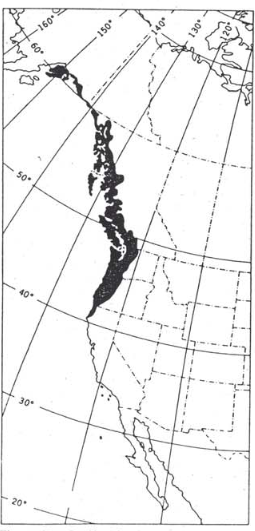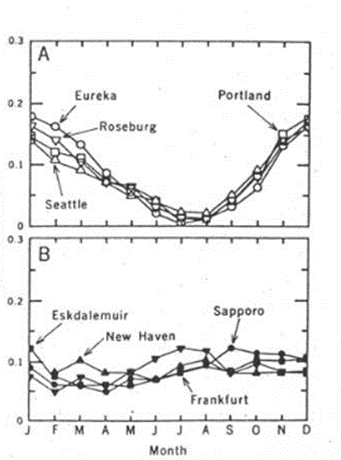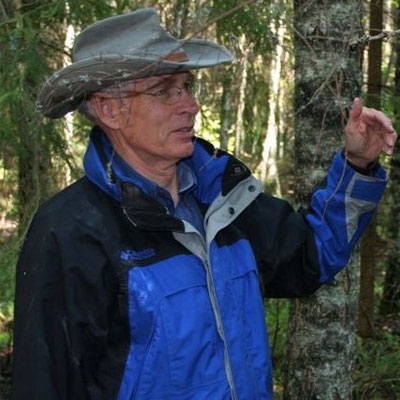When we were growing up, we thought that the only really tall trees in the western U.S. were giant redwoods in northwestern California. It wasn’t until Richard moved to Oregon in the early 1960s that he discovered not only are redwoods exceptionally large, but that all the conifers (e.g., spruces, firs, cedars, hemlocks, and pines) grow taller and can live longer than their relatives elsewhere in the world (see Table 1). Most of the western portion of Oregon is located within the Pacific Northwest (PNW) region that extends from northwestern California all the way to southwestern Alaska (see Figure 1). There are other temperate regions in China, Europe, and the eastern United States with forests that contain conifers. But in those areas, conifers predominate only for a short while following the germination of their seed after a fire or other disturbances. Deciduous hardwood tree species, such as oak, maple, beech, and basswood, eventually replace most of the ‘pioneer’ conifers, except on sandy or rocky soils. It’s the opposite of what happens in the Pacific Northwest. Why is this? Over the last half century, forest scientists have discovered some of the reasons.


A distinct climate
The seasonal pattern in rainfall differs between the PNW and other temperate regions (Figure 2). In the PNW, most of the precipitation falls during the winter months; the summer months are exceptionally dry (Figure 2A). Other temperate regions exhibit a more uniform pattern in the monthly distribution of precipitation (Figure 2B).

The nights are cooler during the growing season in the PNW because the Pacific Ocean provides a mass of cool air, often laden with fog, that moves inland up river drainages during the afternoon and evening. The impact of winter storms is limited to exposed areas along the coast; inland areas are protected behind a ridge of coastal mountains through which rivers twist through canyons on their way to the sea. Because hurricanes and tornados are extremely rare in the PNW, trees can grow much taller and persist much longer than in other temperate forests areas.
Structural features of conifers in the Pacific Northwest region
Most of the major tree species in the PNW evolved from shorter ancestors in China. As climatic conditions became more Mediterranean over thousands of years, PNW conifers evolved, growing taller and living longer than species of hardwoods with which they compete.
The needle-like foliage of conifers dissipates heat more efficiently than broad-leaf hardwoods during the hot, dry summers in the PNW. In addition, most conifers are evergreen, while most hardwoods are not. This enables conifers to photosynthesize, and therefore keep producing carbohydrates, throughout the mild winter months, as well as during the growing season. A final structural advantage of PNW conifers is that they have thick bark for their size. This helps protect the living cells beneath the bark and prevents them from reaching lethal temperatures when wildfires burn through the forests, allowing the trees to survive and grow larger than hardwoods with thinner bark.
Pacific Northwest conifers maintain rapid growth longer than elsewhere
Forest scientists used to puzzle over how PNW conifers grow at a rapid rate for longer than they do elsewhere. The explanation is that they continue to produce copious amounts of new foliage longer than other related species. When foliage production is reduced, less leaf area is available to intercept light for photosynthesis and, hence, growth is reduced. If branches are not shed rapidly, they grow longer. The longer a branch grows, the more tortuous the path for water flow from the stem to the leaves. As temperature increases during the day, the flow of water to leaves slows, causing a reduction in photosynthesis as pores (stomata) on the surface of leaves begin to close. PNW conifers continue to produce more leaves and fewer branches decades longer than related species in other temperate forests. The ability to produce and sustain dense canopies of leaves explains why Pacific Northwest forests, when left undisturbed, accumulate more than twice as much standing biomass and stores of carbon than any other forests on earth.
Climate change endangers Pacific Northwest forests
Dense PNW forests use a lot of water, as much as 5 millimeters (0.2 inches) a day or nearly 6 inches per month in warm dry conditions. With a warmer climate, and their large amount of retained foliage, these forests attain maximum rates of transpiration earlier in the spring. At lower elevations, this results in an increase in soil water deficits that cause trees of all sizes to become more stressed physiologically than they were previously. Mega-wildfires are more frequent and more destructive than the historical norm.
At higher elevations in the Cascade Mountains, less snow accumulates now than in years past, and it melts more quickly in the spring. This means that even the subalpine forests, which evolved with infrequent fire, are susceptible. With continual warming, we may lose the iconic giant conifer trees of the PNW region, along with the carbon they stored in their massive stems, which would be an irreversible loss, analogous to the melting of glaciers because both require such long periods to form.
Acknowledgment
We thank Lise Waring for insightful comments on an earlier draft.
References
Waring, R.H. 1982. Land of the giant conifers. Natural History 91:54-63.pdf



